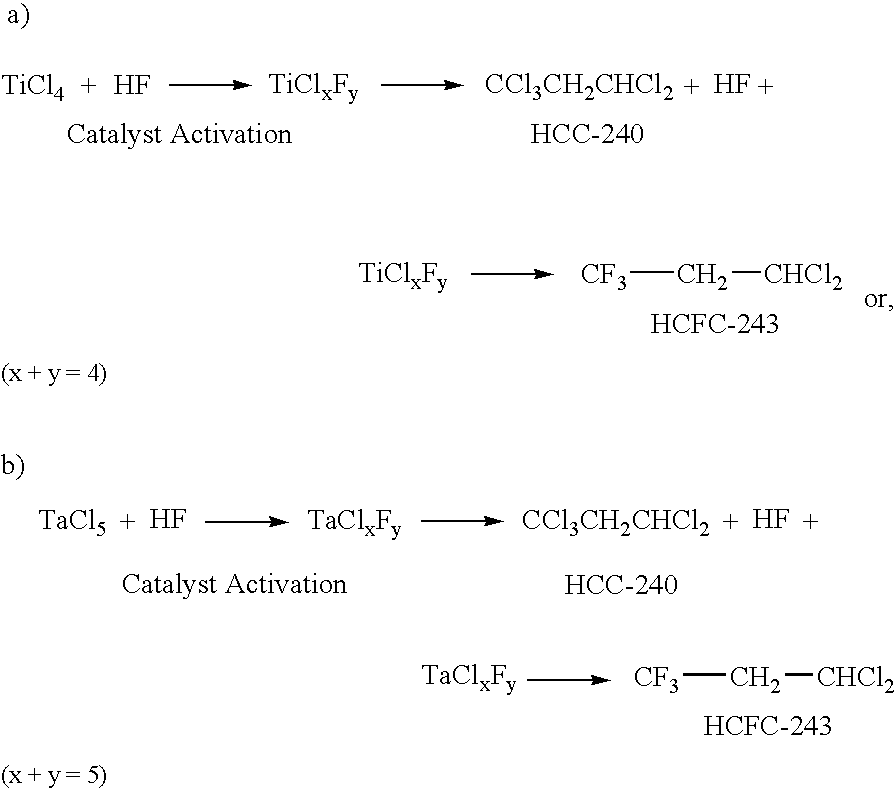Process for the preparation of 1,1-dichloro-3,3,3-trifluoropropane
- Summary
- Abstract
- Description
- Claims
- Application Information
AI Technical Summary
Problems solved by technology
Method used
Image
Examples
example 1
[0025] An active catalyst is prepared by heating HF and Ti(IV)Cl4 in the ratio 7.89:1 (to afford TiClxFy in which x+y=4). Subsequently, a mixture of HCC-240 CCl3CH2CHCl2 (1,1,1,3,3-pentachloropropane), HF and the activated catalyst is heated at elevated temperature (60-100° C.). The molar ratio of HCC-240 (CCl3CH2CHCl2 (1,1,1,3,3-pentachloropropane)) to HF is about 3:1. The ratio of reactants may be adjusted to get better selectivity of the desired product HCFC-243 (CF3CH2CHCl2). The reaction temperature is about 50-100° C. The catalyst used is either TiCl4 or TaCl5. The amount of catalyst employed is about 0.1 mol % to 25% with respect to the starting material CCl3CH2CHCl2. Pressure is about 250-400 psi.
[0026] After the reaction, the by-product formed (mainly HCl) is removed by passing through a base solution of aqueous KOH. The reaction mixture is then quenched with water, the organic layer is separated and treated with a drying agent (MgSO4), filtered and fractionally distilled ...
example 2
[0027] A 450 mL autoclave equipped with a mechanical stirrer was placed under a vacuum and charged with 10.8 g (0.057 mol) of TiCl4. The autoclave was then put into a dry ice container and cooled to −40° C. The cooled autoclave was then charged with 9 g (0.45 mol) HF, taken out of the dry ice container, put into a heater and heated to 75° C. to activate the catalyst, Ti(IV)Cl+HF→TiClxFy, where x+y=4. This caused the generation of HCl and caused the pressure inside the autoclave to increase. After the pressure stopped increasing, the autoclave was taken out of the heater and cooled down to room temperature. The generated HCl was vented through a scrubber, and the autoclave was then put back into a dry ice container. Next, 30.7 g (1.53 mol) of HF was added to the autoclave, and the autoclave was then put into heater and heated to 30° C. Next, 20 g (0.092 mol) of 1,1,1,3,3-pentachloropropane (HCC-240) was added and the autoclave heated to 65-70° C. until there was no more pressure incr...
example 3
[0028] A reaction was conducted as described in Example 1 except a TaCl5 (20.4 g, 0.057 mol) catalyst (Ta(V)Cl+HF→TaClxFy where x+y=5) was used instead of TiCl4. After the reaction, gas chromatography analysis indicated a reaction product of 0.9% CCl3-CH2-CHCl2, 62.3% CF3-CH2-CHCl2, 0.6% CFCl2-CH2-CHCl2, 20.2% CF3-CHCl-CHCl2, and 3.3% CF3-CCl-CCl2.
PUM
| Property | Measurement | Unit |
|---|---|---|
| Temperature | aaaaa | aaaaa |
| Temperature | aaaaa | aaaaa |
| Pressure | aaaaa | aaaaa |
Abstract
Description
Claims
Application Information
 Login to View More
Login to View More - R&D
- Intellectual Property
- Life Sciences
- Materials
- Tech Scout
- Unparalleled Data Quality
- Higher Quality Content
- 60% Fewer Hallucinations
Browse by: Latest US Patents, China's latest patents, Technical Efficacy Thesaurus, Application Domain, Technology Topic, Popular Technical Reports.
© 2025 PatSnap. All rights reserved.Legal|Privacy policy|Modern Slavery Act Transparency Statement|Sitemap|About US| Contact US: help@patsnap.com

